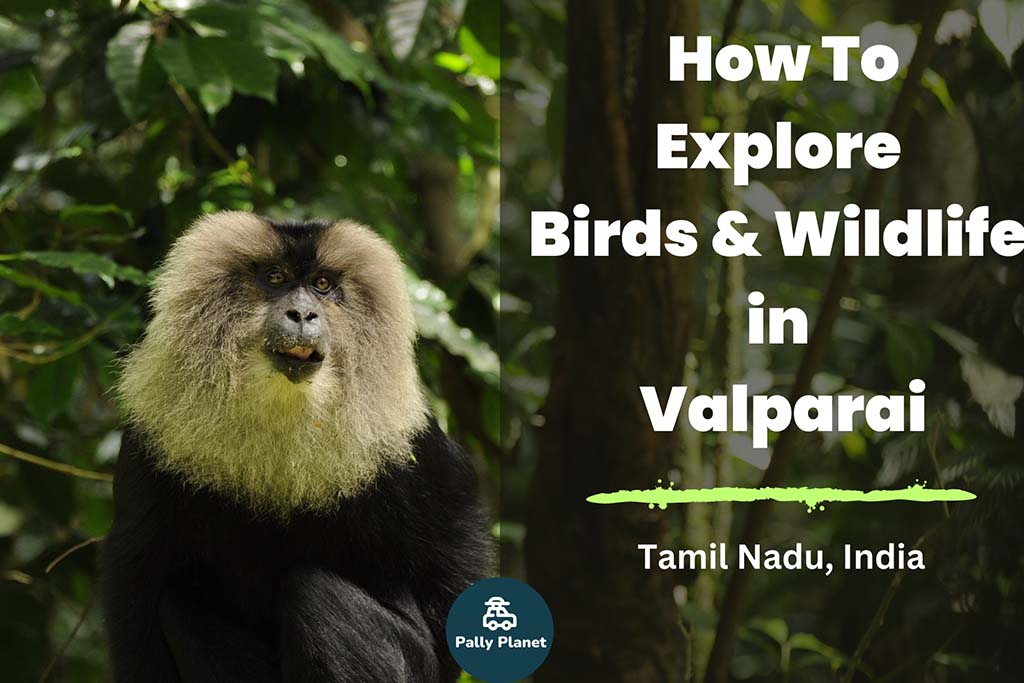Birds and Wildlife of Valparai in Western Ghats

Valparai near Coimbatore is a seldom-visited hill station in the Western Ghats, known for its wildlife and bird-watching opportunities. But, from my experience exploring nature in Valparai, I can tell you that it is an excellent place for birding and wildlife watching, including the western ghat’s endemics.
In this blog, I will explain how to get to Valparai, the history of the tea gardens, the different kinds of forests and mammals found there, the birds were seen there, lodging options, and the ideal times to visit this stunning location.
Climate and Location of Valparai
Valparai is a plantation town in the Western Ghats in the southern part of the Indian Peninsula. The town is in the lap of blue mountains, emerald tea plantations, and lush green forests. Valparai is 3,500 feet above sea level. The place experiences tropical weather year-round, with temperatures ranging from 15 to 30 degrees Celsius. This part of the western ghats gets heavy rainfall during the monsoon, from June to September, making it the perfect location for tea gardens and lush green forests.
How to Reach Valparai:
The Coimbatore International Airport, which is about 100 km away, is the closest airport to Valparai. The best option is to hire a taxi to travel to Valparai on arrival. In addition, there are frequent bus services from Coimbatore, Pollachi, and other nearby cities to the town. If you prefer a scenic route, the road from Pollachi to Valparai travels through thick forests and provides breathtaking views of the surrounding mountains.
History of Valparai Tea Gardens
The history of tea gardens in Valparai dates back to the 19th century. The tea plantations came to Valparai in 1859 after the British introduced tea cultivation to the area in the early 1800s. Several tea estates that produce some of the best tea in the nation are located in Valparai today. In addition to providing a livelihood for the locals, the tea gardens are a top tourist destination with breathtaking views of the lush green tea plantations.
Valparai’s Forests and Types
Valparai is encircled by thick forests supporting various plant and animal life. The Western Ghats have UNESCO-recognized heritage and biodiversity sites, and the Annamalai National Park is one of them. Valparai is an extension of the Annamalai from a wildlife diversity point of view. The zone has Moist Deciduous Forests, Tropical Semi-Evergreen forests, and Tropical Evergreen forests.
Wildlife in Valparai
Valparai is home to various mammals, including several endangered species. Indian gaur and Asiatic elephants grazing in the tea gardens are a common sight in Valparai. There is an impressive population of leopards in Valparai, and a couple of jeep safaris in the evening can get you a glimpse of them. Though tiger sightings are less frequent, the big cat is present in Valparai hills. The place is globally known for the Lion-tailed Macaque, an endemic and endangered primate species of the Western Ghats. Another Western Ghats endemic primate seen here is Nilgiri Langur. Depending on the time of your visit and luck, you may also encounter wild dogs, sloth bears, palm civets, Nilgiri Thar (On Pollachi-Valparai Road) and wildcats. If you’re super lucky, you may even see the rare endemic nocturnal flying squirrel, the Malabar flying Squirrel.
Birds of Valparai
The most famous resident of Valparai is the Great Indian Hornbill. There is a large population of them in and around the town (Valparai-Chalakkudi road). I recall seeing a congregation of more than 50 in a single tree during my visit in 2018. The Malabar Grey Hornbill, Nilgiri Flycatcher, Malabar Trogon, Indian Pitta, Oriental Honey-buzzard, and Black-and-Orange Fly are the few additional birds in Valparai.
The winter months, from October to February, are the best for spotting these birds because many migratory birds stop by the area during this time. Therefore, I am adding an e-Bird report on birds of Valparai here.
Accommodations in Valparai
Visitors can choose from inexpensive lodging to opulent resorts when staying in Valparai. To fully immerse yourself in the community, consider staying in a colonial-era plantation bungalow or a homestay run by local families.
When to Go to Valparai
The post-monsoon season, the six months starting from October, is the perfect time for wildlife enthusiasts. However, if you are keen on seeing Great Indian Hornbill, I suggest travelling a tad later, probably in April, considering the nesting season.

